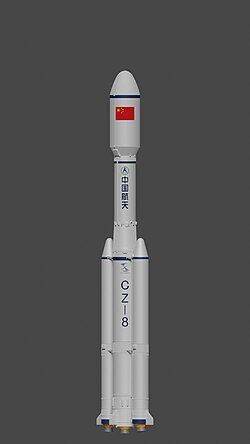Engineering:Long March 8
 Rendering of Long March 8 Y1 | |
| Function | Orbital launch vehicle |
|---|---|
| Manufacturer | China Academy of Launch Vehicle Technology (CALT) |
| Country of origin | China |
| Size | |
| Height |
|
| Diameter | 3.35 m (11.0 ft) |
| Mass |
|
| Stages | 2 |
| Capacity | |
| Payload to SSO 700 km |
|
| Payload to LEO | 8,100 kg (17,900 lb) |
| Payload to GTO | 2,800 kg (6,200 lb) |
| Associated rockets | |
| Comparable | Soyuz-2 Antares Falcon 9 (RTLS reusable) Ariane 6 H3 |
| Launch history | |
| Status | Active |
| Launch sites | Wenchang, LC-2 Jiuquan |
| Total launches | 2 |
| Successes | 2 |
| First flight | 22 December 2020 |
| Last flight | 27 February 2022 |
| Boosters (Standard) – K2 booster | |
| No. boosters | 2 or 0 |
| Length | 26.903 m (88.26 ft) |
| Diameter | 2.25 m (7 ft 5 in) |
| Engines | 1 YF-100 |
| Thrust | Sea level: 1,200 kN (270,000 lbf) Vacuum: 1,340 kN (300,000 lbf) |
| Total thrust | Sea level: 4,800 kN (1,100,000 lbf) Vacuum: 5,360 kN (1,200,000 lbf) |
| Specific impulse | Sea level: 300 s (2.9 km/s) Vacuum: 335 s (3.29 km/s) |
| Fuel | RP-1 / LOX |
| First stage – K3 core module | |
| Length | 25.083 m (82.29 ft) |
| Diameter | 3.35 m (11.0 ft) |
| Engines | 2 YF-100 |
| Thrust | Sea level: 2,400 kN (540,000 lbf) Vacuum: 2,680 kN (600,000 lbf) |
| Specific impulse | Sea level: 300 s (2.9 km/s) Vacuum: 335 s (3.29 km/s) |
| Fuel | RP-1 / LOX |
| Second stage | |
| Length | 12.375 m (40.60 ft) |
| Diameter | 3.0 m (9.8 ft) |
| Engines | 2 YF-75 |
| Thrust | 167.17 kN (37,580 lbf) |
| Specific impulse | 438 s (4.30 km/s) |
| Fuel | LH2 / LOX |
Long March 8 (Chinese: 长征八号运载火箭) is an orbital launch vehicle developed by the China Academy of Launch Vehicle Technology to launch up to 5000 kg to a 700 km altitude Sun-synchronous orbit (SSO).[2] The rocket is based on the Long March 7 with its first stage and two boosters, along with the existing liquid hydrogen burning third stage of the Long March 3A/3B/3C and 7A as its second stage. The boosters are omitted in the "core only" variant that first flew on its second launch in February 2022.[1]
A planned future launch vehicle variant of the Long March 8 will be partially reusable by featuring a combined booster recovery of the first stage and the boosters as a single unit.[3]
The maiden flight of the Long March 8 was launched on 22 December 2020 from the Wenchang Spacecraft Launch Site.[4]
Launch statistics
Script error: No such module "Chart".
List of launches
| Flight number | Date (UTC) |
Variant | Launch site | Payload | Orbit | Outcome |
|---|---|---|---|---|---|---|
| 1 | 22 December 2020 04:37[4][5] |
Standard | Wenchang, LC-2 | Xinjishu Yanzheng 7 (XJY-7) Haisi-1 Tianqi Xingzuo 08 (Ping'an-1) Yuanguang-1 ET-SMART-RSS (Zhixing-1A) |
SSO | Success |
| 2 | 27 February 2022 03:06[6] |
Core only[6] | Wenchang, LC-2 | Dayun (Xingshidai-17) Hainan-1 01, 02 Jilin-1 Gaofen-03D 10–18 Jilin-1 Mofang-02A 01 Qimingxing-1 Taijing-3 01 Taijing-4 01 Tianxian-1 (Chaohu-1) Chuangxing Leishen Wenchang-1 01, 02 XD-1 Tianqi-19 |
SSO | Success |
| 3 | 18 March 2024[7] | Standard | Wenchang, LC-2 | Queqiao-2 Tiandu-1, 2 |
Selenocentric | Planned |
See also
- Long March 9
- Comparison of orbital launchers families
- Comparison of orbital launch systems
- Expendable launch system
- Lists of rockets
References
- ↑ 1.0 1.1 1.2 1.3 "长征八号遥二运载火箭飞行试验取得圆满成功" (in zh-cn). 27 February 2022. http://finance.people.com.cn/n1/2022/0227/c1004-32360646.html.
- ↑ 贾平凡 (2020-12-28). "长征八号首飞成功 中国运载火箭家族再添新成员" (in zh-hans). 新华社. http://www.xinhuanet.com/tech/2020-12/28/c_1126914060.htm. Retrieved 2022-02-27.
- ↑ Jones, Andrew (30 April 2018). "China to test rocket reusability with planned Long March 8 launcher". SpaceNews. https://spacenews.com/china-to-test-rocket-reusability-with-planned-long-march-8-launcher/.
- ↑ 4.0 4.1 Jones, Andrew (22 December 2020). "China launches first Long March 8 from Wenchang spaceport". SpaceNews. https://spacenews.com/china-launches-first-long-march-8-from-wenchang-spaceport/.
- ↑ "长征八号运载火箭首次飞行试验取得圆满成功" (in zh). CNSA. 22 December 2020. http://www.cnsa.gov.cn/n6758823/n6758838/c6810959/content.html.
- ↑ 6.0 6.1 Jones, Andrew (27 February 2022). "China launches national record 22 satellites on Long March 8 commercial rideshare". SpaceNews. https://spacenews.com/china-launches-national-record-22-satellites-on-long-march-8-commercial-rideshare/.
- ↑ Seger Yu [@SegerYu] (2 October 2023). "The Queqiao-2 relay satellite is expected to be launched in March 2024". https://twitter.com/SegerYu/status/1708792564109963686.
 |

